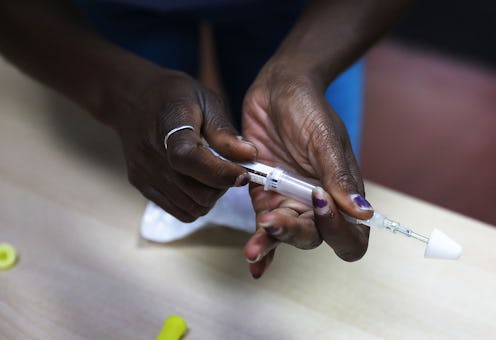
A new report from the CDC's National Center for Health Statistics (NCHS) found that Americans' life expectancy has dropped for the second year in a row — and part of that reason is the growing opioid epidemic. Some 63,600 Americans died of a drug overdose in 2016, according to the NCHS, up from roughly 52,000 in 2015 and more than in any previous year; of those deaths, more than 42,200 involved opioids.
According to CNN, opioids, which make up 66 percent of drug overdose fatalities, now kill more Americans than breast cancer, and drug overdoses as a whole kill more Americans than the entire Vietnam War did. An average of 41,070 Americans die from breast cancer each year, which is less than the number of opioid-related deaths. And 58,000 American soldiers died during the Vietnam War — a number that, although it still surpasses the estimated number of deaths caused by opioids, is now less than the average number of deaths caused by drug overdoses as a whole.
Meanwhile, the impact that the opioid crisis has had on American life expectancy makes it comparable to some of the epidemics in recent U.S. history. According to The Washington Post, the rate of deaths caused by drug overdoses saw a 21 percent increase in 2016, causing American life expectancy at birth to decrease for the second year in a row.
This has not happened since 1962 and 1963, when influenza killed many people and had a significant negative impact on life expectancy. Then, at the peak of the AIDS epidemic in 1993, American life expectancy saw a one-year drop, but the 1960s were the last time the U.S. saw a two-year drop like it is seeing now with drug overdoses. An earlier two-year drop also occurred in the 1920s.
Robert Anderson, who oversees the NCHS' Mortality Statistics Branch, told the Associated Press that American life expectancy typically increases after a one-year drop, and indicated that this two-year drop caused by the opioid crisis should be a cause for concern. “If we don’t get a handle on this,” Anderson said, “we could very well see a third year in a row. With no end in sight.”
The AP pointed out the the U.S. hasn't seen a three-year drop in life expectancy since 1916, 1917, and 1918, at which time the country was experiencing the worst flu epidemic in modern history. Anderson also told The Washington Post that other high-income countries don't have the same problem with life expectancy.
“I think we should take it very seriously,” Anderson told the Post. “If you look at the other developed countries in the world, they’re not seeing this kind of thing. Life expectancy is going up.”
Anderson is right to call for a better handling of the opioid crisis. Data from the CDC indicates that an American baby born in 2016 is expected to live an average of 78 years and 7 months. In 2015, this life expectancy was a month longer, and in 2014, it was two months longer. Moreover, the U.S. ranks below many other high-income countries in life expectancy, including the UK, Sweden, Switzerland, Singapore, and Japan — which ranks the highest, according to the World Bank.
According to the AP, the powerful painkiller fentanyl and related opioids surpassed heroin and prescription painkiller pills in how many overdose deaths they caused. In fact, the AP reported, fatal overdoses caused by fentanyl and similar drugs doubled to 19,000 in just one year, making up approximately 45 percent of all opioid overdose deaths.
In October, President Trump declared the opioid crisis a public health emergency, which is expected to barely make a dent in the problem. Since his announcement in October, Trump has relegated minimal further resources to addressing the crisis, and lawmakers are worried that this lack of follow-through will enable the fatal overdose rate to continue rising, even as the overall national death rate declines.